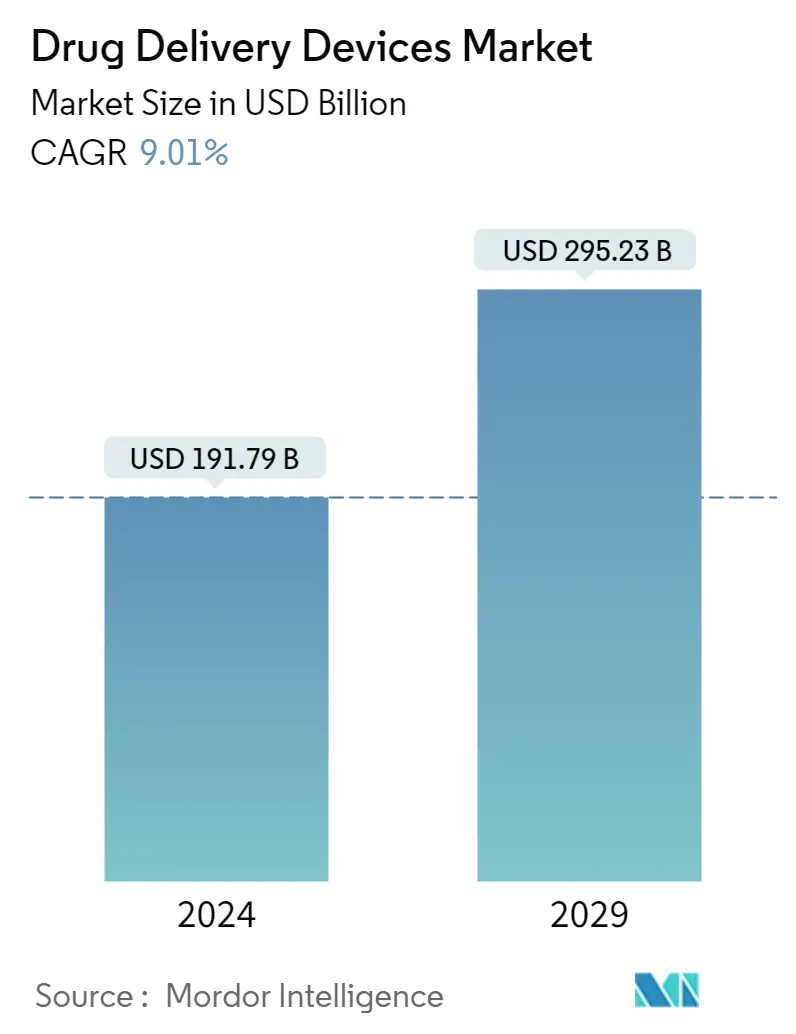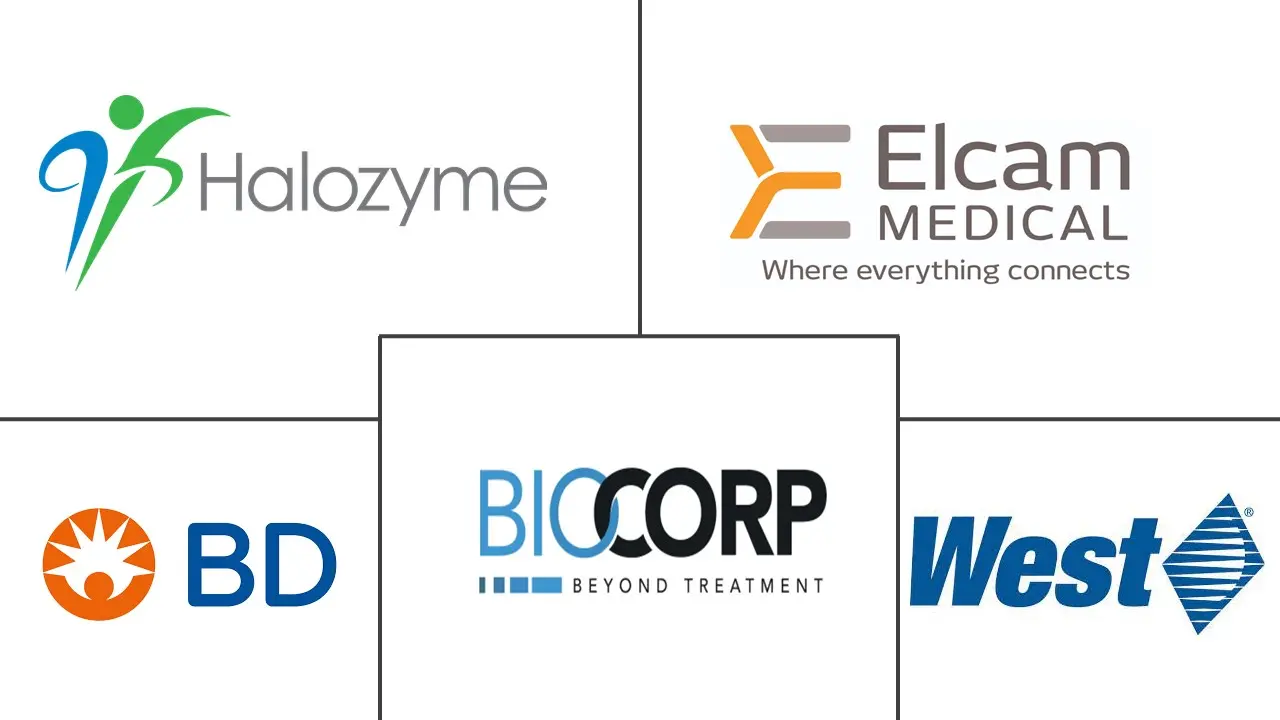Market Size of Drug Delivery Devices Industry

| Study Period | 2021 - 2029 |
| Market Size (2024) | USD 191.79 Billion |
| Market Size (2029) | USD 295.23 Billion |
| CAGR (2024 - 2029) | 9.01 % |
| Fastest Growing Market | Asia Pacific |
| Largest Market | North America |
Major Players
*Disclaimer: Major Players sorted in no particular order |
Drug Delivery Devices Market Analysis
The Drug Delivery Devices Market size is estimated at USD 191.79 billion in 2024, and is expected to reach USD 295.23 billion by 2029, growing at a CAGR of 9.01% during the forecast period (2024-2029).
With the outbreak of COVID-19, most pharmaceutical companies and governments were and are working toward offering efficient medical treatment to COVID-19 patients, and drug delivery devices are expected to play a vital role in this context. For example, large-scale vaccination programs are being undertaken all over the world to immunize people against the SARS-CoV-2 virus. However, still, many companies are working on more efficient ways of delivering COVID-19 therapeutics to patients and investing heavily in them, which is expected to have a significant impact on the drug delivery market. For instance, in February 2022, Glenmark Pharmaceuticals Limited launched a nitric oxide nasal spray called FabiSpray in India for the treatment of adult patients with COVID-19 who had a high risk of progression of the disease. Currently, the usage of drug delivery devices for COVID-19 treatment has slowed down; hence, COVID-19 had a significant impact on the drug delivery market initially. However, the market is expected to experience steady growth over the forecast period.
The rising prevalence of chronic diseases, technological advancements, and the growth of the biologics market are significant factors expected to drive the development of the drug delivery devices market over the forecast period. As drug delivery devices help deliver the drugs, which are beneficial for the targeted population to recover faster, there has been a growing adoption of and inclination toward advanced drug delivery devices. Moreover, a rising number of cancer, respiratory disease, and diabetic patients worldwide may promote the adoption of drug delivery devices and drive the overall market. According to the data published by the International Agency for Research on Cancer 2020, globally, 1 in 5 people develop cancer during their lifetime, and 1 in 8 men and 1 in 11 women die. Breast, colorectal, lung, cervical, and thyroid cancers are common among women. In contrast, lung and prostate cancer are the most common among men, accounting for nearly one-third of all male cancers. This growing burden of cancer increases the adoption of drug delivery devices, which will contribute significantly to the market's growth over the studied forecast period.
Additionally, the article published by Frontiers in July 2020 mentioned that it is necessary to develop appropriate delivery systems and complete therapy strategies according to the nature of drugs and diabetes mellitus. As per the source, drug delivery devices have been potentially beneficial in many aspects of diabetes treatment, with effects such as improving the stability of drugs, overcoming different biological barriers in vivo to increase bioavailability, and acting as an intelligent, automated system to mimic endogenous insulin delivery and reduce the risk of hypoglycemia. These are the advantages of diabetes treatment devices. Therefore, the increasing demand for novel drug delivery devices is expected to boost the growth of the market studied.
The technological advancements in drug delivery devices are going to make them more patient-friendly, accessible, and accurate. In line with this, players invest more in research and development and continuously innovate new technologies and advanced drug delivery devices. In May 2021, Phillips-Medisize launched its Aria Smart Autoinjector platform, which unlocked innovation, differentiation, and sustainability in the digital drug-delivery device market. This device features advanced technologies such as a modular drug delivery platform that supports a variety of drug formulations and viscosities and has built-in Bluetooth, which enables connectivity to smartphones, tablets, and mobile apps. In addition, Roche has developed a Port Delivery System with ranibizumab (PDS), a drug delivery implant, to free patients with wet age-related macular degeneration from the need to undergo frequent eye injections in June 2021. The FDA granted this PDS drug delivery implant priority review. This active involvement of the major players is anticipated to have a considerable impact on the growth of the studied market.
Thus, all the aforementioned factors are expected to boost market growth over the forecast period. However, the risk of needlestick injury may restrain market growth over the forecast period.
Drug Delivery Devices Industry Segmentation
As per the scope, drug delivery devices or systems are the tools used to deliver the drug through the specific route of administration. It enables the introduction of therapeutic substances into the body. The drug delivery devices market is segmented by route of administration (injectable, topical, ocular, and others), application (cancer, cardiovascular, diabetes, infectious diseases, and other applications), end user (hospitals, ambulatory surgical centers, and other end users), and geography (North America, Europe, Asia-Pacific, the Middle East and Africa, and South America). The report also covers the estimated market sizes and trends for 17 countries across major regions globally. The report offers the value (USD million) for the above segments.
| By Route of Administration | |
| Injectable | |
| Topical | |
| Ocular | |
| Other Route of Administration |
| By Application | |
| Cancer | |
| Cardiovascular | |
| Diabetes | |
| Infectious diseases | |
| Other Applications |
| By End User | |
| Hospitals | |
| Ambulatory Surgical Centers | |
| Other End Users |
| Geography | ||||||||
| ||||||||
| ||||||||
| ||||||||
| ||||||||
|
Drug Delivery Devices Market Size Summary
The drug delivery devices market is poised for significant growth over the forecast period, driven by the increasing prevalence of chronic diseases, technological advancements, and the expansion of the biologics market. The market's expansion is further supported by the rising adoption of advanced drug delivery systems, which are crucial for the effective treatment of conditions such as cancer, diabetes, and respiratory diseases. The COVID-19 pandemic initially spurred demand for these devices, as they played a vital role in vaccination and therapeutic delivery. However, as the pandemic's impact has waned, the market is expected to continue its upward trajectory, fueled by ongoing innovations and strategic initiatives by key industry players.
North America is anticipated to be a significant contributor to the market's growth, driven by the high incidence of chronic diseases and a robust pipeline of new product launches. The region's market is bolstered by strategic partnerships and collaborations aimed at enhancing production capabilities and developing novel drug delivery systems. Major companies in the market are focusing on research and development, strategic alliances, and the introduction of new products to maintain their competitive edge. Despite the moderately competitive landscape, the market is expected to experience healthy growth, supported by the continuous evolution of drug delivery technologies and the increasing demand for efficient therapeutic solutions.
Drug Delivery Devices Market Size - Table of Contents
-
1. MARKET DYNAMICS
-
1.1 Market Overview
-
1.2 Market Drivers
-
1.2.1 Rising Prevalence of Chronic Diseases
-
1.2.2 Technological Advancements
-
1.2.3 Growth in the Biologics Market
-
-
1.3 Market Restraints
-
1.3.1 Risk of Needlestick Injuries
-
-
1.4 Industry Attractiveness - Porter's Five Forces Analysis
-
1.4.1 Bargaining Power of Buyers/Consumers
-
1.4.2 Bargaining Power of Suppliers
-
1.4.3 Threat of New Entrants
-
1.4.4 Threat of Substitute Products
-
1.4.5 Intensity of Competitive Rivalry
-
-
-
2. MARKET SEGMENTATION (Market Size by Value - USD million)
-
2.1 By Route of Administration
-
2.1.1 Injectable
-
2.1.2 Topical
-
2.1.3 Ocular
-
2.1.4 Other Route of Administration
-
-
2.2 By Application
-
2.2.1 Cancer
-
2.2.2 Cardiovascular
-
2.2.3 Diabetes
-
2.2.4 Infectious diseases
-
2.2.5 Other Applications
-
-
2.3 By End User
-
2.3.1 Hospitals
-
2.3.2 Ambulatory Surgical Centers
-
2.3.3 Other End Users
-
-
2.4 Geography
-
2.4.1 North America
-
2.4.1.1 United States
-
2.4.1.2 Canada
-
2.4.1.3 Mexico
-
-
2.4.2 Europe
-
2.4.2.1 Germany
-
2.4.2.2 United Kingdom
-
2.4.2.3 France
-
2.4.2.4 Italy
-
2.4.2.5 Spain
-
2.4.2.6 Rest of Europe
-
-
2.4.3 Asia-Pacific
-
2.4.3.1 China
-
2.4.3.2 Japan
-
2.4.3.3 India
-
2.4.3.4 Australia
-
2.4.3.5 South Korea
-
2.4.3.6 Rest of Asia-Pacific
-
-
2.4.4 Middle East and Africa
-
2.4.4.1 GCC
-
2.4.4.2 South Africa
-
2.4.4.3 Rest of Middle East and Africa
-
-
2.4.5 South America
-
2.4.5.1 Brazil
-
2.4.5.2 Argentina
-
2.4.5.3 Rest of South America
-
-
-
Drug Delivery Devices Market Size FAQs
How big is the Drug Delivery Devices Market?
The Drug Delivery Devices Market size is expected to reach USD 191.79 billion in 2024 and grow at a CAGR of 9.01% to reach USD 295.23 billion by 2029.
What is the current Drug Delivery Devices Market size?
In 2024, the Drug Delivery Devices Market size is expected to reach USD 191.79 billion.

